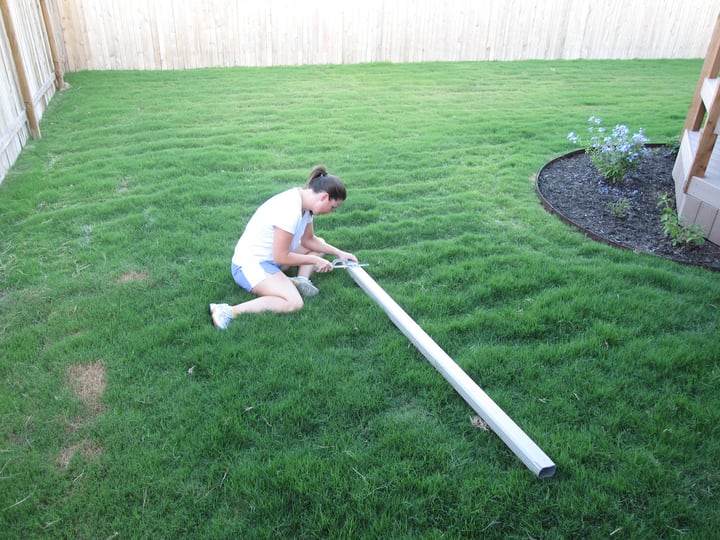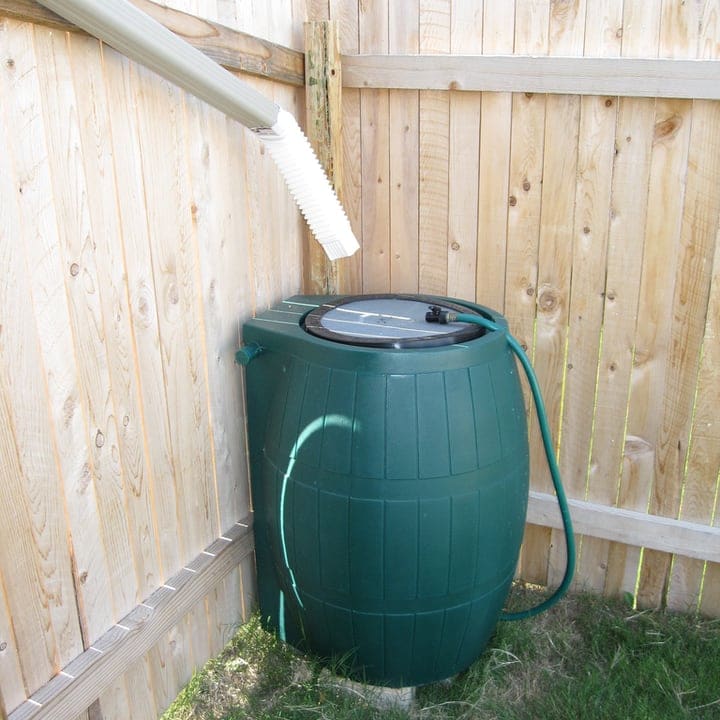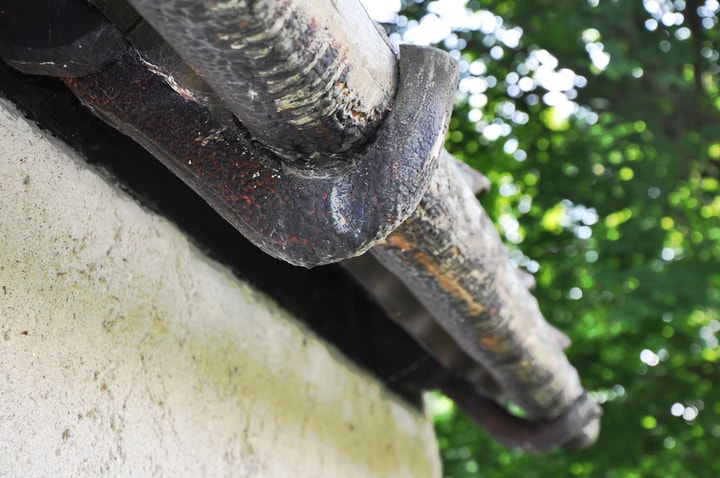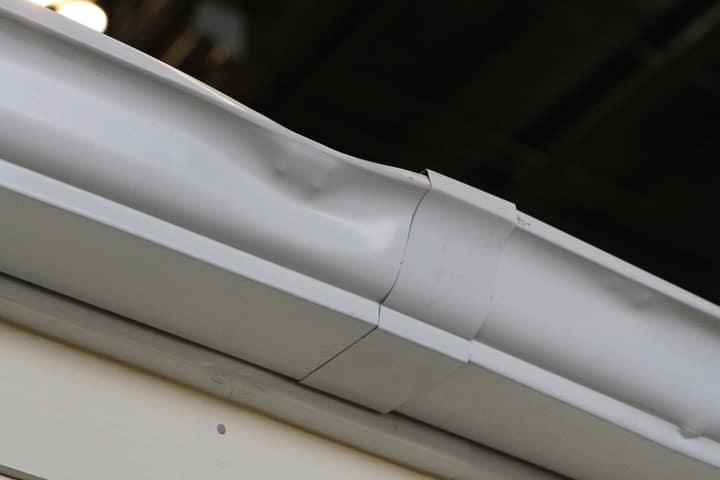Rain gutters may not sound fun, but they can be an effective way to recycle water. Whether you already have rain gutters or are thinking about installing some, in this post we’ll show you how to make the most of them.
We’re talking about rain water harvesting here, a simple and effective way to collect water for plants and animals in a way that is beneficial for the environment. And saving water in the process.
People often underestimate the importance of rain gutters. But rain gutters can unload tons of rainwater from the roof during a taxing storm.
Where does all that water go? Well, it’s really up to you.
Why Use Rain Gutters to Harvest Water
Rain gutters protect the walls and foundation of your house and help you avoid pooling.
You can also use your gutters to collect stormwater and use this water for gardening and other purposes (more on that in a bit).

Benefits of recycling water include:
- Helps you save water
- Improves the health of your garden
- Has a beneficial impact on the environment
- Provides you with a valuable backup of water you can use during droughts
- Reduces the risk of floods on your property after a heavy downpour
Rain Gutters Water Usage
How can you use the rainwater you harvest via rain gutters? In plenty of ways. Here are some ideas to inspire you.
Hydroponics and Aquaponics
With some creativity, you can use rainwater for hydroponic systems or for aquaponics.
These systems can circulate water continuously meaning that you only have to change it now and then.
They can help you save water while speeding up the growth of different types of crops.
Flower Garden
Rainwater is very healthy for garden plants. That’s why it’s a good idea to collect water during a downpour that you can then give to your plants and garden flowers to drink.
If you collect it in a rain barrel, you can use a plastic watering can or bucket to take the water straight from the barrel. If the mouth of the barrel is large enough, you won’t even need a spigot.
Vegetable Patch
Rain water is also great for watering salad, lettuce, cucumbers, sweet potato, and all your other garden crops.
If you plan to use rainwater for this purpose, make sure to place your rain barrels a short distance away from your vegetable patch.
Water Features
Rain water may not be ideal for swimming pools (without a filtering system in place at least).
But you can use it for ponds, waterfalls, fountains, and other creative water features like those in a Japanese garden.
Depending on the water features you have, you may need to set up a pipe delivery system from the rain water container.
Water for Pets and Animals
Fresh rainwater is good for pets and other animals you may raise, including rabbits and chickens.
Just make sure the water doesn’t become stagnant before you give it to them.
Other Uses
You can use rain water for lots of other purposes including washing vegetables and dishes in an outdoor kitchen, washing laundry, washing the car, bathing, watering houseplants, and composting.
Important: Before we move on, keep in mind that at the time of writing, Colorado and Utah regulate rainwater harvesting. Make sure to check local regulations before continuing with this guide.
Types of Rain Gutters
Rain gutters may all look alike when painted, but they can be made from different materials and there can be notable differences between them.
Making the right choice means you can save money as well as a great deal of work. Let’s take a look at the most widely used types of rain gutters.
Wood Gutters
In recent years, wood gutters have been making something of a comeback. They can look really good and if you have them checked and sealed regularly, can last a really long time.
They are heavier than other options, though, and require a careful installation. Add to this their cost (including maintenance), and you’re looking at a higher end choice.
Copper Gutters
Another high-end choice, copper rain gutters look great and last a long time if properly installed.
You don’t have to paint them regularly because of the patina they take on with time. So if you don’t want to worry too much about maintenance, they are a smart choice.
But there must be some downsides, right? These rain gutters are some of the most expensive on the market.
In most cases, you may not be able to make them or install them yourself, which adds to the cost and could mean you may have to call on a professional if they get damaged in time.
Aluminum Gutters
An affordable choice, rain gutters made from aluminum don’t rust and are lightweight and easy to install. You can also paint them any color you want.
What about the cons? Well, aluminum is not the most durable material. If you get harsh winters there or violent storms, these gutters may need fixing and replacing before long.
Despite the cons, though, aluminum gutters are a very accessible choice that makes good sense if you want a quick upgrade from old gutters.
Vinyl Gutters
A more recent development, vinyl gutters are some of the cheapest around. An important advantage they have is that they are not likely to corrode or dent.
Plus they are lightweight and available in multiple colors so you can install them without any hassle.
Good to know: Vinyl gutters are not the strongest and may sag under a burden of snow.
If you get heavy snowfalls where you live, they may not be the best option. They may also crack if they undergo freezing–especially the cheaper options.
Another thing to consider is the fact that vinyl may contain substances that may be toxic.
If you are going to use them to recycle the water for growing vegetables or raising animals, you want to check to make sure that they won’t leak any harmful substances.
Steel Gutters
Steel gutters can be stainless or galvanized. Stainless steel gutters are more durable as they don’t corrode or rust and can withstand damage (such as from a heavy hailstorm).
If you don’t live in a hot climate, they are a dependable choice. Drawbacks include high cost, limited coloring options, and their tendency to expand and then contract if exposed to continuous heat.
The Bottom Line
There’s no one size fits all solution here. The type of gutters you choose depends on your budget, the colors and styles you want, and whether you’re willing to put in some DIY work in installing and maintaining them.
How to Install Rain Gutters
Whether you need to replace old gutters or install new ones, you want to make sure you have the right tools.
The exact installation process may differ slightly depending on the type of gutters you’ve opted for but the main steps are the same.
What You’ll Need
- Gutters, including flashing, hanging strap, and sealant
- Downspouts
- Elbows
- Self-tapping hex screws
- Medium length rivets
- Cordless drill with hex head driver
- Rivet gun
- Tall step ladder or extension ladder
Check the video below for a simple video tutorial.
Tip: Make sure to use leaf gutter guards to protect your gutters from debris.
Don’t have the time or the tools to install rain gutters? It’s better to leave the work to a pro than to make a poor job of it or worse, to injure yourself in the process.
How to Recycle Water with Your Rain Gutters
Once you have installed rain gutters or upgraded old ones, you’re ready to start using them to harvest water. It’s not hard at all.
Rain Gutter Water Recycling Instructions
Follow these simple steps to create a simple and inexpensive system for recycling water using your rain gutters.
Step 1 – Ensure Your Roof Is in a Good State

It all starts with a well-maintained roof. Issues with your roof such as leaks and debris will affect the efficiency of your water harvesting and possibly cause a host of other problems.
If you haven’t had your roof checked in a long time, now’s the time to do it. But unless you know what you’re doing, we recommend calling a pro for this task.
If the roof needs repairing or fixing, do these before moving on to the next step. You can do this in pretty much any season except for mid to late winter.
Step 2 – Get the Rain Gutters and Downspouts Ready

Your gutters will be doing the heavy work, so make sure they are in good shape.
The first thing you want to do is clear them of of dead leaves and other debris. Bear in mind that bees or wasps may sometimes make their nests in gutters, so be careful.
You also want to install gutter guards (see above) to keep your gutters clean and ensure a good flow into your rainwater collecting barrels.
Gutter guards are inexpensive and easy to find.
Step 3 – Adjust the Downspout(s)

The tip of the gutter downspout should fall a short distance above the barrel.
Depending on the current configuration of your gutters, you may have to install additional downspouts (see video above) or cut existing ones.
Before you get down to the actual work, you may want to draw some basic plans on paper to figure out how many downspouts you’ll need.
As a rule, it’s best to have several as that will ease the pressure off the gutters and reduce the strain on long ones.
Step 4 – Install the Rainwater Harvesting System

Whether you use a repurposed barrel or a new one, place it safely on level ground.
Add to the barrel a spigot or use piping. You can buy a water harvesting kit for this.
For more information, check our complete guide on rain water harvesting where we feature easy kits you can buy online.
Step 5 – Use the Water Within Days

Stagnant water is a breeding ground for algae and mosquitos. Plus it smells bad!
If you want to store some of the water, consider using a water feature or reservoir with a filtration system.
Rain Gutters Maintenance
If you want to get the benefits of rain gutters, it’s essential to keep them clean before spring and fall. Moreover, you may have to clean them immediately after a serious storm.
Small stones, soot, dust, dead leaves, and other items carried by the wind can block the downspouts.
A congested downspout may add serious weight to your gutters.

Clogging may result in structural damage and other issues on the roof, foundation, and walls.
Tip: If you don’t have the time for cleaning your rain gutters, it’s best to call a pro to do the cleaning at least once or twice a year and possibly more often depending on the climate you live in.
Rain Gutters Water Recycling Commonly Asked Questions
Next, here are some of the most frequent questions we’ve been hearing on water recycling using rain gutters. We hope you find the answers useful!
How do you dispose of rainwater?

The easiest way to dispose of rainwater is to use rain gutters to direct it towards a rain barrel with a spigot or connected to a hose.
You can then use rainwater for your flower garden and vegetables, give to animals to drink, or save up in case of drought.
Why do my gutters overflow in heavy rain?

The edge of the roof may drain over or behind the gutter rather than in it. Or else you may have too few downspouts or the gutters are too small to handle the rainfall in your region.
Check the rain gutters and replace them if needed.
Are rain gutters really necessary?

Without rain gutters, rain falling off your roof may cause flooding, erosion, water puddles, and damage to your patio, flower garden, or pathway.
How do I get rid of standing water in my gutters?

Long gutters may develop a flat spot in the middle. Try to pitch the gutter in one direction or another to train water or install another downspout in the problem area.
Let It Rain!
Make your rain gutters work for you–with a few simple rain water harvesting barrels and some well-positioned downspouts you can collect a lot of water which you can then reuse in useful ways.
Setting up rain gutters for recycling water may not be as fun as creating a flower bed or planting a magnolia tree.
But in the long run, it will make a positive impact on your garden water consumption and the health of your plants.
Get your gutters checked and set up a simple rain water harvesting system–it’s a good long term strategy.
Now we’d love to hear from you. Have you ever collected rain water using gutters or other methods?
Drop us a comment and tell us all about it.
And, of course… Let it rain!
















It’s good to know that rain gutters could improve the aesthetic appeal of your home while protecting it from damage. My husband and I plan to have our dream home constructed soon since we recently amassed a large sum of money from his inheritance. I’ll share this with him so we can have rain gutters installed in our new home. Thanks!
Hey Levi! Thank you for your comment, and I totally agree with you. Good luck with the construction of your dream home, hopefully with some dream rain gutters;) Regards, Jiri
I’ve been wanting to have a gutter installed on my roof because I noticed due to heavy rain, the roof is starting to sag. Once it’s installed, I’ll keep in mind to have it regularly clean, especially before spring and fall. I’ll also make sure to connect the downspout to a drum.so more water would be saved.
Hey Rachel, sounds great! We are happy to learn that our brief guide has helped you! We’d love to see how it turns out when you’ve finally installed id. You can send me some snaps at [email protected]!
It’s great to learn that you should get your rain gutters cleaned before spring and fall. My wife and I are wanting to buy a new house together and we were wondering how to maintain a gutter system with a new home. I’ll be sure to tell her that we will need to get our gutters cleaned twice a year.